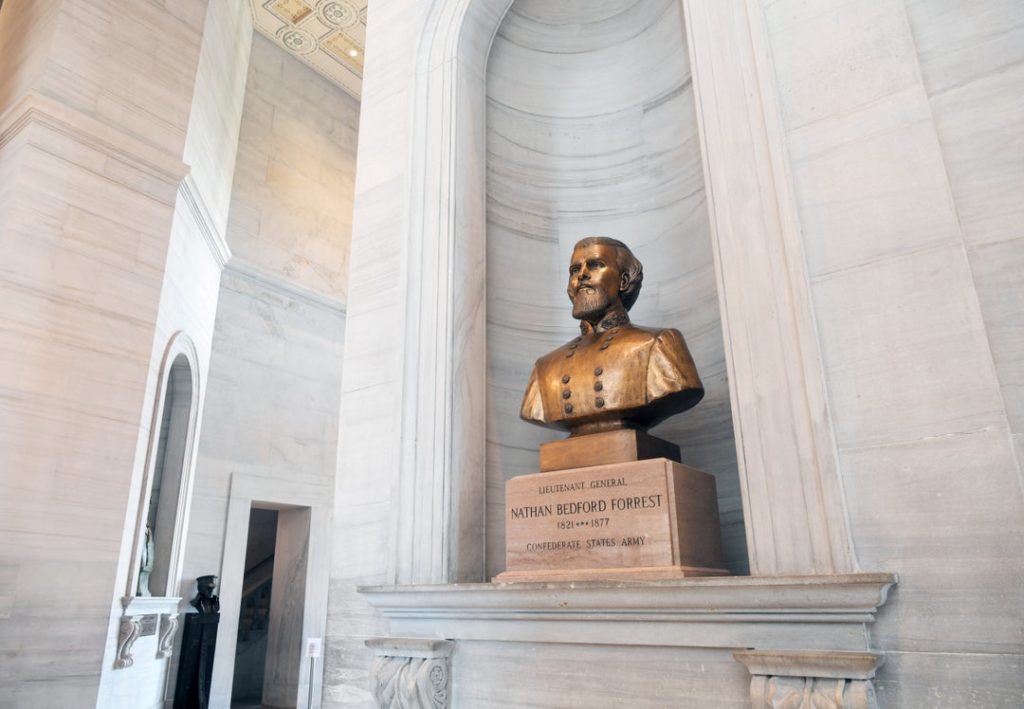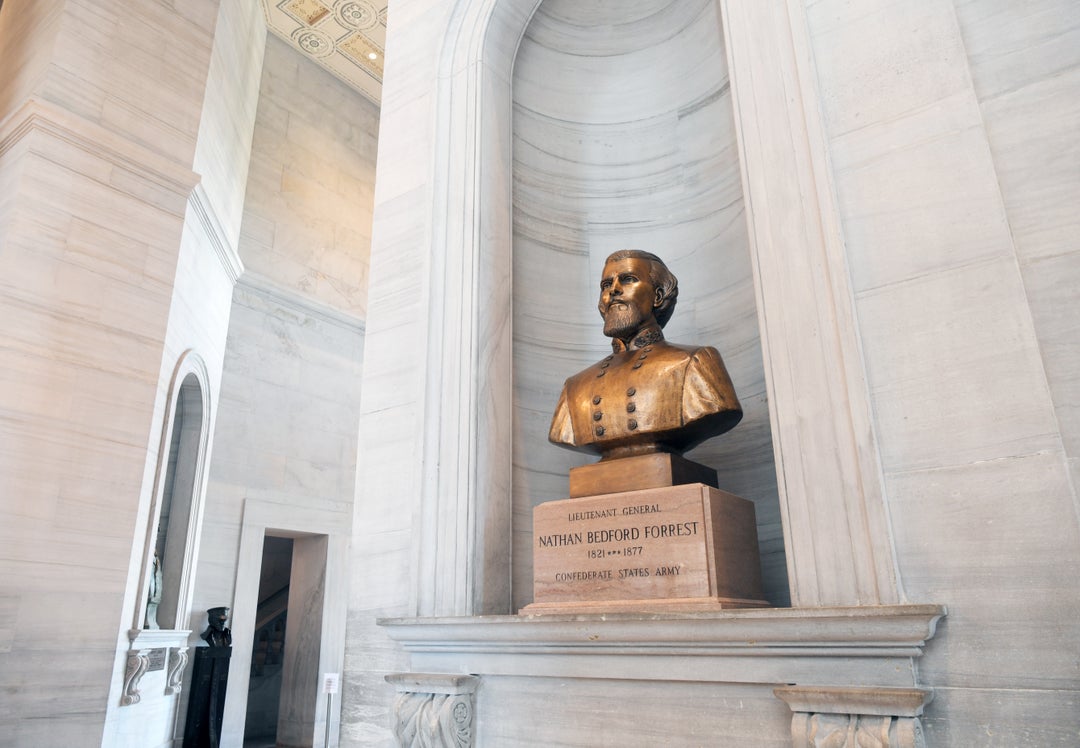Capitol Commission approves moving Nathan Bedford Forrest bust to Tennessee State Museum – Tennessean

Tennessee’s State Capitol Commission on Thursday voted to remove a bust of Confederate Lt. Gen. Nathan Bedford Forrest, a significant step in a decades-long fight over the controversial fixture that has remained outside the House and Senate chambers.
And despite initially intending only to vote on the removal of Forrest’s bust, the commission ultimately voted in support of removing busts of U.S. Admiral David Farragut, a leader in the Union Navy during the Civil War, and U.S. Admiral Albert Gleaves, who served during the Spanish-American War and World War I. Busts of the two admirals are also currently featured in the Capitol.
The commission met at the request of Gov. Bill Lee and voted in favor of a modified proposal from what he had announced the day before: petition the Tennessee Historical Commission for a waiver to relocate the Forrest bust to the Tennessee State Museum.
They voted 9-2 to do so, a much different outcome from the commission’s vote three years ago on removing the Forrest bust. Protesters crowded in the lobby erupted in cheers at the completion of the meeting.
In a statement after the vote, Lee commended the commission for “arriving at a thoughtful resolution.”
“Scripture implores us to live in peaceful unity and I believe today’s actions reflect this and our commitment to remembering all parts of our past,” Lee said.
State Comptroller Justin Wilson, an ex-officio member of the commission, made the move to include the relocation of Farragut and Gleaves, in addition to Forrest.
Per Wilson’s amendment, the three busts are to be relocated to the state museum to be part of an exhibit “honoring Tennessee military heroes,” language that some members of the commission, specifically Nashville Criminal Court Clerk Howard Gentry, said they took issue with.
While Lee came in person to address the commission at the state’s Tennessee Tower office building, he let comments he made at his briefing Wednesday speak for themselves. Instead, he thanked members for “doing the due diligence and wrestling through the process” of coming to a decision on the matter.

The governor in recent months has maneuvered outside of public view to facilitate the removal of the bust, which was installed in 1978. While former Gov. Bill Haslam, a fellow Republican, came out in favor of removal during his time in office, the State Capitol Commission in 2017 failed to approve removal.
But this time around, ex-officio members who had voted against removal in 2017, including Secretary of State Tre Hargett, Treasurer David Lillard and Wilson, voted in favor of relocating the bust.
Each of the governor’s three commissioners serving as ex-officio members of the committee also voted in favor of removal, as did each of Lee’s citizen appointees.
Sen. Jack Johnson, R-Franklin, and Rep. Matthew Hill, R-Jonesborough, were the only votes against removal. Johnson said his vote “represents the will of the Senate,” citing concern over the widespread removal of statues recently.
Johnson, who was on the commission in 2017 and also voted against removal at the time, said Thursday he privately polled Senate members. A total of 19 were against removal of the bust and 14 were for it, he said. Lt. Gov. Randy McNally, R-Oak Ridge, has remained firmly against removing the bust from the Capitol.
Hill said he, too, was representing his chamber’s preference with his vote.
A commission position remained unfilled Thursday, an ex-officio seat previously occupied by the late Reavis Mitchell, chairman of the Tennessee Historical Commission, who died last month. His replacement will be named Friday at a separate THC meeting.
Commissioners, secretary of state say it’s time for removal
Capitol Commission chairman Butch Eley, who is also the commissioner of the state’s Department of Finance and Administration, recalled growing up in Cheatham County in the 1960s.
The county integrated the year he began school.
“That experience made me certainly acutely aware that the unspoken rules legally kept us together, but practically kept us apart,” Eley said. “It’s clear to me, also, that this bust is a stark reminder of the painful ideology and way of life that has caused tremendous anguish and distress on many African Americans.”
Members of the commission discussed receiving thousands of emails about the issue, and some said they carefully reviewed many of them.
General Services Commissioner Christi Branscom, another Capitol Commission ex-officio member, was among those who spoke.
“Displaying his bust in the Capitol suggests to all visitors that he represents the values of our state, and that his life is worthy of emulation,” she said. “It is not.”
Department of Environment and Conservation Commissioner David Salyers noted ahead of the vote that relocating the bust to the museum “will not delete history or erase history.”
Hargett said he believed that after the Forrest bust is removed, one of the state’s accomplished and historic women should be featured, since none of the Capitol busts portray females.
The matter of the Forrest, Farragut and Gleaves busts will now be taken up by the Tennessee Historical Commission, though likely not until its October meeting. From there, that panel will have to finalize its vote at a second meeting. The THC typically holds meetings in February, June and October.
A two-thirds vote of the 20-member historical commission is required to move the busts, meaning Lee will likely have to continue working behind the scenes in order to secure final passage.
Democrats, Republicans testify before commission about bust
The Capitol Commission heard lengthy testimony from several lawmakers before taking a vote.
“The world will not end if we remove the Nathan Bedford Forrest bust out of the state Capitol of Tennessee,” said Rep. Harold Love, D-Nashville. “The world will not end. the mountains will not fall into the sea and the rivers will not dry up.”
After the meeting, Love celebrated the vote, noting that the commission had more Black representation on it than it did in 2017, given Lee’s appointment of two additional African American members to the commission.
Sen. Brenda Gilmore, D-Nashville — like Love, a fellow member of the Black legislative caucus — said her eyes tear up when she exits the elevator in the Capitol to immediately face the Forrest bust.
“I can hear the wails and the cries of over 200 surrendered soldiers,” Gilmore said, referencing the battle Forrest led at Fort Pillow. “Soldiers that had surrendered and were still slaughtered by his command. Surely an unnecessary killing.”
At Fort Pillow in West Tennessee, Confederate troops under Forrest’s command killed an estimated 200 to 300 surrendered Union troops, most of whom were Black.
In addition to his role as a cavalry commander, Forrest was a slave trader before the Civil War and an early leader in the Ku Klux Klan.
“I can hear the mothers and the crying children, and feel their fear as the Ku Klux Klan terrorized them and burned their homes for no other reason than they were Black,” Gilmore said.
As a couple dozen protesters crowded into the lobby of the Tennessee Tower, four Democratic legislators came to speak in favor of removal and two Republicans spoke — one against, one neutral — before hearing from six members of the public who addressed the commission by video conference.
Members of the commission could at times hear shouts from protesters, who were watching by web stream and had not been permitted to enter the meeting due to limits on room capacity.
Sen. Joey Hensley, R-Hohenwald, spoke against removal, arguing in part that there were a large number of African Americans who attended Forrest’s funeral.
While Rep. Mike Sparks, R-Smyrna, also made a similar argument about funeral attendance, he clarified after his lengthy remarks that he did not have a firm position on whether the bust should be relocated to the museum, but rather wanted more resources devoted to telling the story of Sampson Keeble, the state’s first Black lawmaker.
Hensley also defended Forrest by asserting he was “in the Ku Klux Klan, but he was not a grand wizard,” despite many historians believing he held that position. Forrest was not, however, the founder of the KKK.
Multiple historians provided testimony, including Timothy L. Wesley, an associate professor of Civil War-era history at Austin Peay State University, and Learotha Williams, an associate professor of African-American and public history at Tennessee State University.
Both advocated for removal of the bust.
A single member of the public, attorney Doug Jones, who represents the Sons of Confederate Veterans, spoke against removal.
Legislature in 2016 made it more difficult to remove bust
Installation of the Forrest bust was spearheaded by the late Sen. Douglas Henry, a Democrat from Nashville. The General Assembly in 1973 had approved a resolution ordering that a bust of Forrest be created for the Capitol.
It was sculpted by Loura Jane Herndon Baxendale, who was married to a member of the Sons of Confederate Veterans.
Two years after it was installed, in 1980, the Tennessee chapter of the Invisible Empire Knights of the Ku Klux Klan gathered in front of the bust to hold a news conference to talk about their ongoing training efforts to prepare for a potential “race war,” according to Tennessean archives.
In 2016, the legislature approved a law that requires anyone interested in renaming, removing or relocating any statues, monuments and other memorials on publicly owned land to receive a two-thirds majority vote from the Tennessee Historical Commission.
Reach Natalie Allison at nallison@tennessean.com. Follow her on Twitter at @natalie_allison.
About the busts
Nathan Bedford Forrest: Forrest, from Memphis, was a slave trader before the Civil War. During the war, he became a famed Confederate cavalry commander. He commanded troops at the battle of Fort Pillow, where hundreds of Union soldiers died, many of them Black troops who had surrendered. After the war, he became an early leader of the Ku Klux Klan. He died in 1877.
David Farragut: Born James Glasgow Farragut, the East Tennessee native was one of the most famous U.S. naval commanders of all time. He stayed loyal to the Union during the Civil War. He became the first rear admiral, vice admiral and admiral in U.S. Navy history. He led forces in capturing New Orleans and Mobile Bay during the war. He died in 1870.
Albert Gleaves: Gleaves, born in Nashville, was a decorated U.S. Navy admiral and served in the Spanish-American War and during World War I. He received the Distinguished Service Award from both the navy and U.S. Army. He died in 1921 and is buried in Arlington National Cemetery.
Want to read more stories like this? A subscription to one of our Tennessee publications gets you unlimited access to all the latest politics news, podcasts like Grand Divisions, plus newsletters, a personalized mobile experience and the ability to tap into stories, photos and videos from throughout the USA TODAY Network’s 261 daily sites.
Published 3:32 PM EDT Jul 9, 2020
